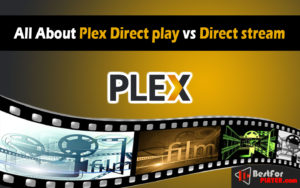All About Plex Direct play vs Direct stream
All About Plex Direct play vs Direct stream: Plex was designed to let multiple Apps play media on an unconnected server. It allows you to playback media locally on your internet, stream it via the internet, or physically sync it to the mobile device. What device can handle this format? Do you have enough power to playback this high-resolution video?
The Server has been created to eliminate these issues and make it easier for you to not fret about the technical aspects. There are three types of outcomes that could be possible. Some Apps offer options to allow you to control how they’re employed.

Contents
How a media file is structured
Every video file saved in your laborious drive is not only an easy file with the video and audio joined. In all blogs today, I will provide you with information containing four main elements: Plex Direct play vs Direct stream.
You may also read: How to delete a plex server.
Container: mp4, Mkv, Avi, and so forth.
A container is that – it continues the video and audio stream and any incorporated subtitles. Relying on the container, it might probably have several audio streams comparable to stereo and encompass sound.
Audio codec: AAC, AC-3, DTS, MP3, etc.
Audio streams use additional codecs, just like video streams. The broadest and most widely supported codecs are AAC and AC-3. Some holders support several audio streams compared to Mkv, and each stream is encoded using a particular codec.
Subtitles: SRT, VOBSUB, PGS, and so forth.
The final part of a video receptacle is the subtitles. These can embody subtitles of pure languages or for languages utilized in fantasy motion pictures. Folks might even burn some subtitles into the video to avoid adding the subtitles later.
Every video file you add to Plex will embody the above elements within the video vessel. Judgment on how your video file is encoded – which video and audio codecs are used – will make maintaining your Plex server more accessible.
Every shopper you use to play a file can play particular codecs of movies and audio codecs. A shopper may also be capable of a video under a selected bitrate – often covered in megabits per second (Mbps). Understanding what your shopper gadgets will help is significant to make sure you get the very best expertise out of Plex.
There are three ways Plex will deal with streaming media to a shopper machine. Plex Direct play vs Direct stream
Here is How to move Plex library to another computer?
Direct Play
That is the final word that means you need your Plex Media Server to deal with media file streaming to a shopper machine. When Plex prefers to play a file straight, the media file is 100% appropriate for the shopper machine, and the Plex server must do nothing with the media file besides ship it to the shopper machine.
Since Plex solely sends the media file to the shopper as-is, this methodology uses virtually no CPU on the server.
Direct Stream
The following neatest thing to direct taking part in a media file is to stream it. Plex chooses to straight stream a file to a shopper when the shopper would not natively help the media file container. For instance, your media file is in an Mkv container. However, the shopper solely allows mp4. Plex will Remax the file by copying the video and audio streams right into a client-compatible container.
Direct Stream wants minimal CPU utilization in your Plex Media Server.
Plex Direct play vs Direct stream: Transcoding
If your shopper would not help both the video or audio stream of your media file? Plex would wish to transform the conflicting stream right into an appropriate format.
If Plex must transcode the video, it will probably require a lot of CPU; conversely, the transcoding audio will have to use the same CPU. Suppose the machine you are using does not repair the plexus properly. Then you will face many problems in making your system.
As well as, in case your CPU is not highly effective sufficient to transcode video or audio on the fly, chances are you’ll discover vital buffering because the shopper machine waits for Plex to transcode the stream and ship it to the shopper.
A wide range of people supports formats (plex direct stream vs direct play)
If you manage your Plex server, you’ll likely want to direct the playback of the media as often as you can. This will help decrease the CPU used by your server and enable users to play more files.
To direct the playback as much as you can and be sure not to transcode in the process, you’ll need to identify the devices connected to the Plex server. It’s easy when only your devices are being used for connecting to the Plex server. However, when you allow other people not in your residence to access your media, the process becomes a little more complex.
The best place to start the coding for your multimedia files would be to employ one of the formats below:
- Container: mp4
- Resolution: 1920×1080 or lower
- Codec for video: H.264 (level 4.0 or less)
- Framerate: 30 fps (bit depth: 8)
- Audio Codec: AAC (2 channels)
- Bitrate 20Mbps or less
This is Jack author of BestForPlayer.com. I would like to write content on this blog.



